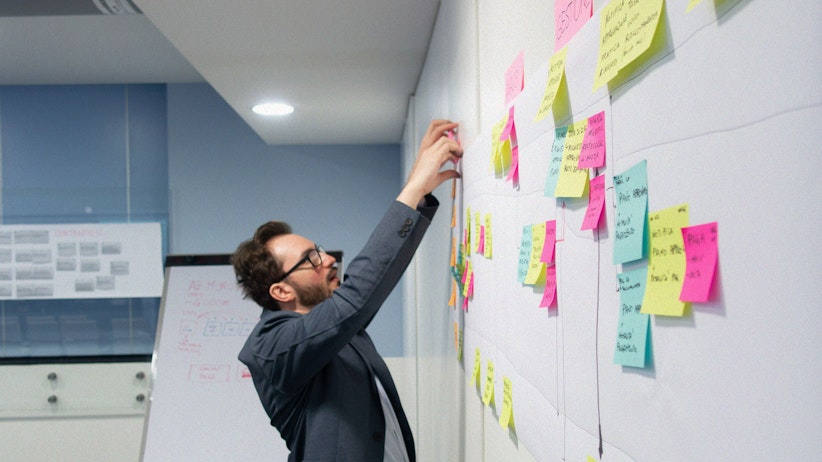Design Thinking 101
Design thinking is a methodology that promotes participatory processes applicable to different areas and goals and that allows you to achieve better results in less time.
The distinctive elements of design thinking are:
- Participation. During the design thinking workshops each participant will have the opportunity to contribute to the conception, design and validation of the solution, according to a co-generative design model.
- Time. The direct and experimental approach typical of design thinking allows to compress in a few days the work of analysis, conception and sharing that usually takes months.
- Tangible output. The result of the workshop is a concept able to anticipate the possible problems that the project may encounter and to address the solutions.
What can be used for?
Taking on a project with design thinking is always a new challenge. Each project is different from the previous one because of the nature of the company involved, the human and professional environment in which we operate and the goals of the project. In spite of this, our experience in this field has allowed us to define four aspects that are alwais present in the various projects:
Lateral thinking or creative problem solving
The main goal is to produce innovative solutions. Starting from the user needs, the creation of the greatest number of creative solutions is encouraged and then filtered until the dominant solution is obtained.
Creative confidence and team building
Design thinking workshops has the ability to promte innovation even within the corporate mindset: creating trust in creative processes, willingness to innovate and collaboration.
Rapid prototyping
In order to contain risks and anticipate problems, the rapid prototyping technique allows companies to touch with their hands what only a few days before was a vision through the creation of a high-level interactive prototype.
Innovative business vision
Digital transformation for companies does not only mean discovering innovative solutions, but also redefining the corporate vision. By associating an innovative value system to their goods or services, it is possible to produce value both for the end customer and for the company itself.
Why opt for design thinking?
- Having a tool that can take you from vision to testable prototype in a short time is a could be differentiating factor in order to accelerate the time to market.
- The co-generative approach ensures a high level of adoption.
- A unique collaboration space with defined timeframes compress the time dedicated to information retrieval between departments, avoiding unnecessary meetings and creating an environment of co-responsibility that will improve the entire company's approach to innovation.
- Each person involved will feel part of a creative process in which the company values their professional contribution, motivating them to achieve business objectives.
- The alternative is to take a leap into the void with a parachute that has not been tested.
How does it work?
The workshops are characterized by divergent moments, which allow the full exploitation of individuality, and convergent moments, during which the group focuses on a shared solution.
Each workshop is unique, tailor-made designed on the basis of 5 fundamental logical steps.
“Five logical steps to co-generate better products.”
Understand
We define the goal and align the team on a common understanding of the problem to be solved, the existing constraints, and the opportunities to be seized.
Explore
We explore possible solutions to the problem, stimulating the generation of potentially effective ideas.
Decide
We analyze the proposed solutions and converge towards those considered most suitable.
Prototype
We produce a concept of the main features of the product, usually as a navigable prototype.
Validate
We test the prototype and collect feedback on which to base next processing cycles.
Who participates?
In the preparation phase of the workshops we involve high-level business figures, representing the different areas of the company, to get to know the company's background, long-term vision and the purpose of the project. We also involve end-users to be able to think from their point of view, understand the context in which they move and discover their needs.
We work with teams of 5/7 people, but we are able to manage multiple teams during the same workshop. The teams are heterogeneous, composed of people with different ages, skills, knowledge and attitudes, led by the project leaders.
Participants are decided together with the project managers, assuming that there are no roles or personal characteristics to be excluded: the whole process tends to stimulate and facilitate the personal contribution of all participants.
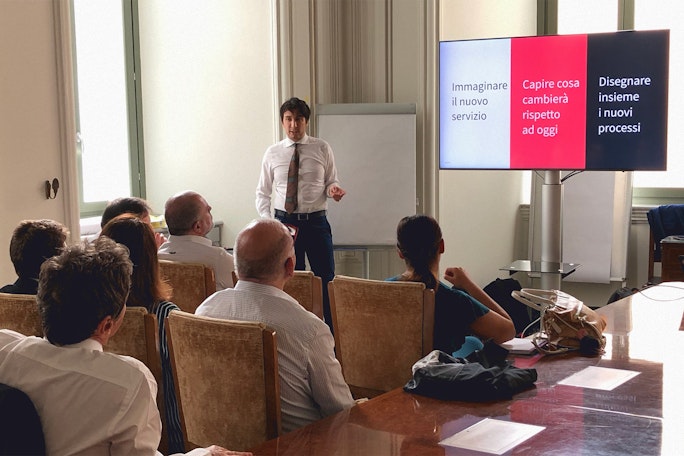

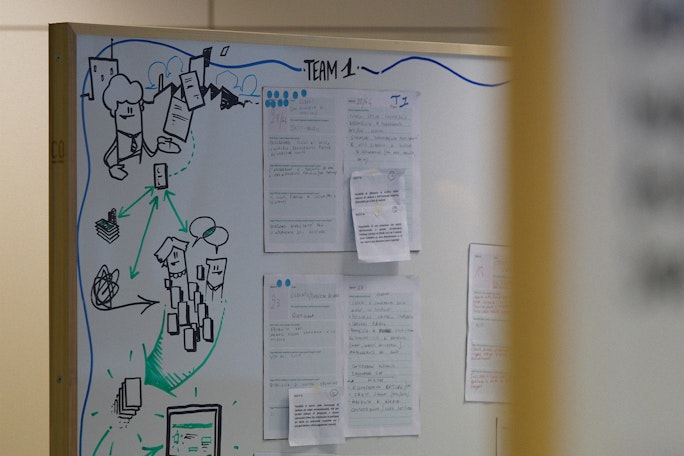
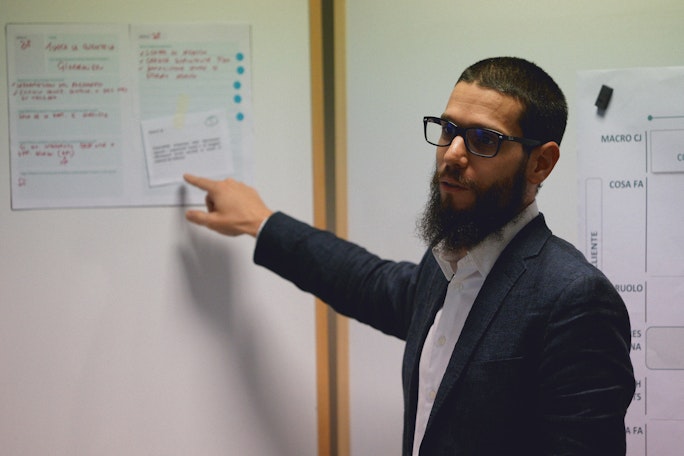
What do you get in the end?
Throughout the process a single interdisciplinary team, composed of people from our team and the client's team, works side by side following the phases of the program.
The results are manifold, some of which go beyond the specific goals of the project, generating value in the participants and, as a consequence, in the company.
Validated prototype
In a very short time we will go from idea generation to the realization of a high-level navigable prototype with related feedback from the testing phase.
Alignment
All participants will be aligned on a shared vision and can be involved in updating even those who did not actively participate in the workshops.
New mindset
Design thinking is a change in perspective. Empowering colleagues to offer their input, and seeing tangible results in such a short time, builds trust and improves the perception of the company from within.
Roadmap
The identified priorities will form the basis of the work plan, which may include new workshops.
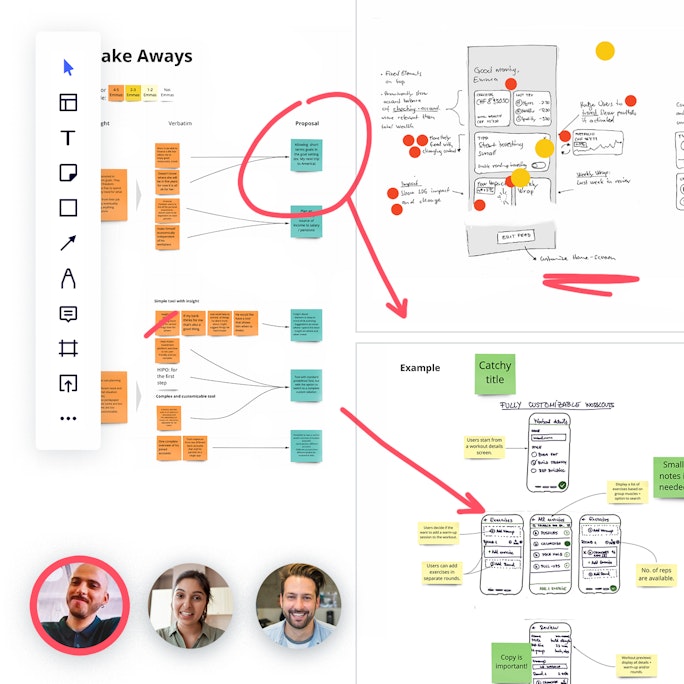
Even remotely
The design thinking workshop is a collaborative experience whose physical presence component has always been a key element. However, in a period of digital innovation (and not only) like the one we are experiencing, physical presence can't and shouldn't be a limitation anymore. Smart working or remote working are increasingly a reality in many companies.
For this reason, we have ideate a smart methodology capable of exploiting the potential offered by technology to our advantage in order to offer an even more effective and immediate digital space for collaboration.
Smart workshop
- No longer physical but mental presence. Remote collaboration allows us to connect people who otherwise would not have been able to collaborate.
- Post-it 2.0. Using different digital tools we are able to combine the benefits of co-design with the speed and flexibility of the digital medium.
- Less time, more quality. We engage participants and help them focus on the workshop objectives
Is it suitable for my company?
We have had the opportunity to successfully test the methodology with clients that are very different from each other in terms of company size and composition, market, mindset and corporate values.
We quickly realized that every project is unique, so we have refined our methodology by paying particular attention to flexibility in order to ensure a tailored experience for each client.


